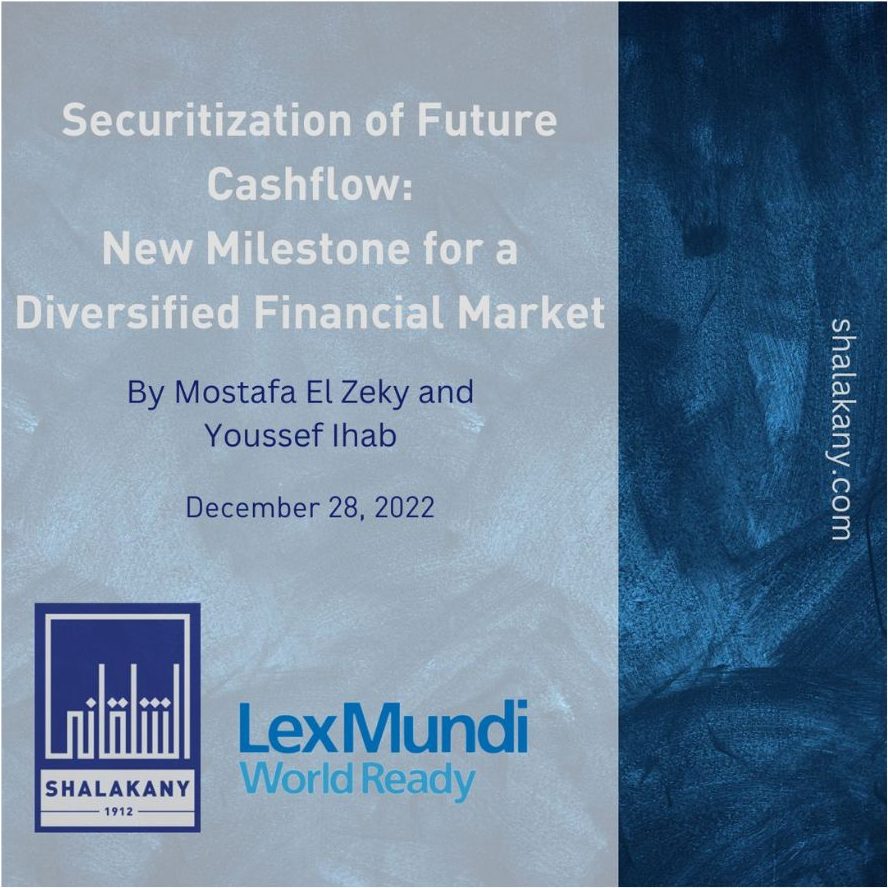Following amendments to the Capital Market Law earlier this year introducing issuance of bonds covering future cashflows, the Financial Regulatory Authority’s (“FRA”) Board of Directors Decree No. 115 of 2022 (the “Decree”) introduced more implementation details relating to future cashflow securitization.
We will outline the major provisions of the Decree below.
General Conditions
Securitization companies are allowed to issue bonds whose proceeds finance expected future cashflows of public or private juristic persons (i.e. assignors), provided that the cashflows are:
-
- Realized for the benefit of a public or private juristic person;
- Free from any restrictions or conditions; and
- Free from any current or future third-party rights.
Based on an assignment agreement between the assignor and the securitization company, a percentage of the future cashflows resulting from a specific or various projects is assigned to the securitization company during a specific period. Bond holders have a lien on the securitization portfolio which guarantees payment of the bonds’ principal and yield. Other additional security may also be provided for that purpose.
The assignor must comply with, inter alia, the following upon issuance of any bonds:
-
- Obtaining a minimum credit rating score from an authorized institution of no less than (BBB-) renewable throughout the issuance period.
- Disclosing in its issuance prospectus or information memorandum a summary of its financial statements and financial information prepared in accordance with the Egyptian Accounting Standards, covering three years prior to the issuance or otherwise the period between the assignor’s incorporation and the issuance, accompanied by an auditor report thereon.
- Determining in detail the future cashflows subject to the securitization, as well as submitting evidence of continuation of these cashflows during the issuance period.
- Determining the security that will guarantee the bondholders’ rights.
Procedures for the Issuance
Like any other bond issuance, bonds secured by future cashflows must be issued on the basis of a prospectus or an information memorandum. In addition to the general requirements under the Capital Market Law, the Decree further requires the following, inter alia:
-
- A summary of the assignment contract;
- Statements of the estimated future cashflows subject to the securitization portfolio during the issuance period, as well as the basis for their preparation. These should be accompanied by an auditor’s report on the statements’ assumptions;
- Credit rating score of the assignor and the bonds; and
- Risks that may face bondholders and the related mitigants.
The securitization company must deposit with the custodian within three days from the subscription coverage of the secured bonds the following:
-
- Original copy of the prospectus or information memorandum as certified by the FRA;
- Copy of the FRA approval on the issuance of the bonds;
- Original copy of the assignment agreement;
- Original copy of the collection agreement between the assignor and the securitization company or the entity mandated with collecting the future cashflows; and
- Documents related to the securitization portfolio and the related security.
Market Reaction
Dr. Mohamed Farid, Chairman of the FRA, commented that future cashflow bonds are innovative financing instruments that enable public and private entities to develop their activities. They also enable public utility and service entities to secure the liquidity required to improve their services.
The FRA’s role in implementing this new financing method was lauded by market players, such as Mr. Karim Awad, CEO of EFG Hermes and Dr. Amr Hassanein, Head of MERIS.



